Search Results

- IDNO:
- 041129
- Title:
- Ancient Quarter and Entrance to Saalgasse; Frankfort on Main, Germany
- Date:
- ca. 1930-1945
- Description:
- A raumbild-verlag (stereocard) of a historic Frankfurt area called Saalgasse before Germany was bombed during World War II.

- IDNO:
- 041130
- Title:
- Saalgasse In Ruins, Frankfort on Main, Germany
- Date:
- ca. 1945
- Description:
- A raumbild-verlag (stereocard) of what was left of the ancient quarter and entrance to Saalgasse after Germany was bombed during World War II.
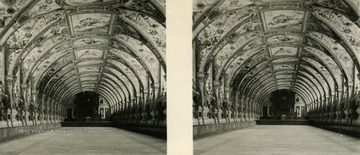
- IDNO:
- 041131
- Title:
- Kings Residence Antiquarium; Munich, Germany
- Date:
- ca. 1930-1945
- Description:
- A raumbild-verlag (stereocard) of a historic Munich building before Germany was bombed during World War II.
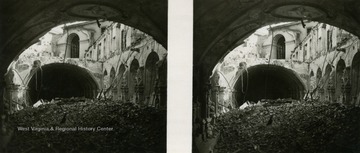
- IDNO:
- 041132
- Title:
- Remnants of Kings Residence Antiquarium; Munich, Germany
- Date:
- ca. 1945
- Description:
- A raumbild-verlag (stereocard) of a historic Munich building after Germany was bombed in World War II.
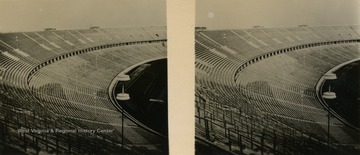
- IDNO:
- 041133
- Title:
- Stadion of Olympiade, Berlin, Germany
- Date:
- 1936
- Description:
- A raumbild-verlag (stereocard) of the Stadion of Olympiade. This area was not badly damaged during the war, and was taken over in 1945 as the headquarters of the British military contingent in Berlin. Returned to German control in the mid-1990s, much of this area remains today as it did in 1936, still a sports center.
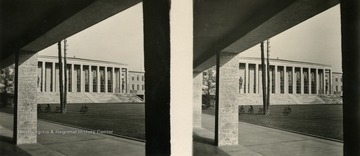
- IDNO:
- 041134
- Title:
- Stadion of Olympiade, Hous of German Sports, Berlin, Germany
- Date:
- 1936
- Description:
- A raumbild-verlag (stereocard) of the Stadion of Olympiade, Hous of German sports. This area was not badly damaged during the war, and was taken over in 1945 as the headquarters of the British military contingent in Berlin. Returned to German control in the mid-1990s, much of this area remains today as it did in 1936, still a sports center.
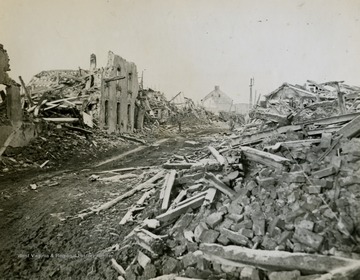
- IDNO:
- 041142
- Title:
- Dachau In Ruins Around Time of Liberation of Concentration Camp, Dachau, Germany
- Date:
- 1945
- Description:
- The town of Dachau dates back to the Middle Ages and at one time was home to many of Germany's artists.
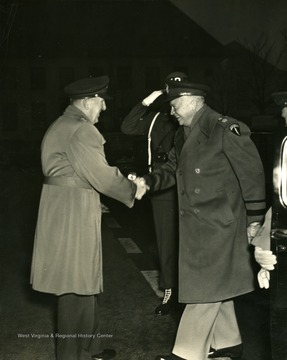
- IDNO:
- 041143
- Title:
- General Eisenhower and Allied Officer Shaking Hands
- Date:
- ca. 1945
- Description:
- Dwight D. Eisenhower, Supreme Commander of all Allied Forces in the European Theater during World War II, is greeted by an unidentified officer. Eisenhower toured several Nazi Concentration Camps immediately after they were liberated in order to personally testify to the heinous Nazi war crimes.
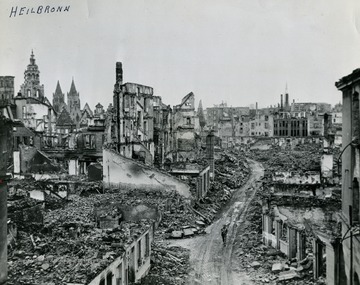
- IDNO:
- 041144
- Title:
- German Rail Center Blasted By Allied Air Attacks, Heilbronh, Germany
- Date:
- ca. 1945
- Description:
- Information with the photograph, "A lone soldier of the 100th Infantry Division, Seventh U.S. Army, walks through the ruins of Heilbronn, Germany, cleared of the enemy April 12, 1945. Forty miles southeast of Mannheim and the Rhino, Heilbronn, an important road and rail center was blasted by Allied Planes. U.S. Signal Corps Photo."
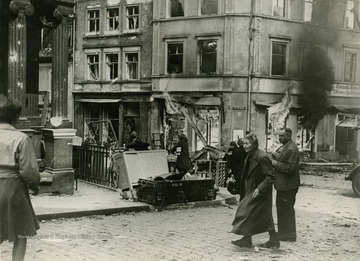
- IDNO:
- 041145
- Title:
- German Citizens After U.S. Occupation of City, Germany
- Date:
- 1945
- Description:
- Building in back cente and right, is still burning as people carry what belongings they have left with them in the streets.
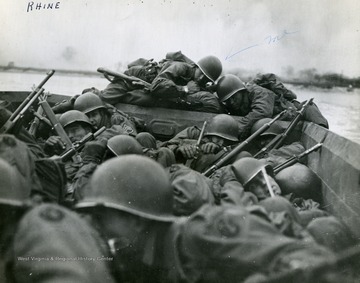
- IDNO:
- 041146
- Title:
- Third U.S. Army Troops Cross Rhine in Germany
- Date:
- 1945/ 03
- Description:
- Information included with the photograph, "Troops of the Third U.S. Army crouch low as enemy fire opens during their crossings of the Rhine in assault boats at Oberwesel, Germany. The Army first forged the river March 22, 1945." Note the label "me" on the photograph most likely points to Raymond Young, infantryman and combat photographer.
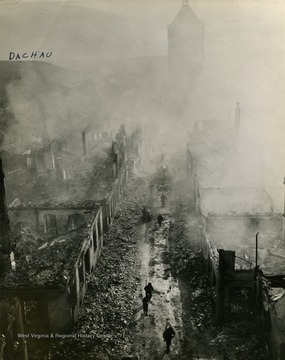
- IDNO:
- 041147
- Title:
- Destruction of Dachau By U.S. Troops, Dachau, Germany
- Date:
- 1945/ Spring
- Description:
- Soldiers walk throughout the streets of Dachau. Buildings were demolished during bombings and the United States Army assaults, followed by the liberation of prisoners held in Dachau concentration camp.